Leatt-Brace DBX Comp – Protection for your neck!
In our sport of downhill (DH), whether you are racing or just riding downhill trails, nothing boosts more confidence than having the right protection. Other than the obvious – helmet, you can now have protection for your neck. The Leatt-Brace DBX Comp employs the patented Alternative Load Path Technology (ALPT) which minimizes movement of your neck upon a crash.
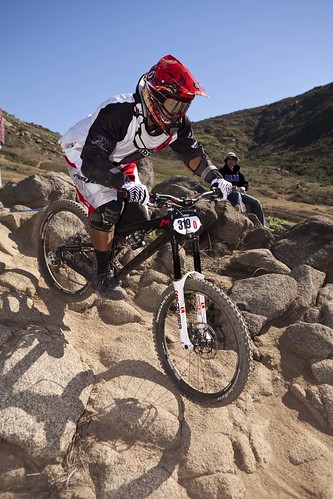
SRC Winter Series 2, Photo by Jason Cleghorn, www.cleghornphotography.com
The Leatt-Brace, maker of the moto neck brace has come out with a specific brace for bicycles – the DBX Comp (Downhill and BMX). Although similar in appearance as the moto neck brace, the DBX Comp is constructed with thinner pads, ¼” thinner vs. the moto. The DBX helps protect riders from head or neck impacts. The ALPT helps disperse the energy that is typically transferred to the neck, resulting from an impact to the head and assists in the transferring of forces away from the vulnerable neck structures to less vulnerable areas of the body and is pivotal in the design of all Leatt-Braces.
The DBX (and other Leatt-Braces) helps protect the rider from the following scenarios:
– Hyperextension: Extreme bending of the head in a rearward direction
– Hyperflexion: Extreme bending of the head in a forward direction
– Lateral Hyperflexion: Extreme bending of the head to one side
– Posterior Hypertranslation: Movement of the head relative to the neck, at ninety degrees to the neck.
– Axial Loading (when combined with Flexion, Extension and Lateral Flexion): Helps prevent axial loading when the axial forces act in combination with bending moments or shear forces. As an example, this typically occurs when your head is forced downward and forward (Hyperflexion) or downward and backward (Hyperextension).
Specs on the Leatt DBX:
– Injection molded
– Glass reinforced
– Nylon neck brace system
– Designed by medical professionals and motorcycle enthusiasts to help prevent extreme neck movements upon a crash
The DBX Comp’s key parts are the neck brace which are two pieces – front and back. The front includes the piece that sits on your chest and the back piece includes the thoracic member. The front and back are connected by “pins”, one on each side. A strap is included to keep the brace in place (optional).
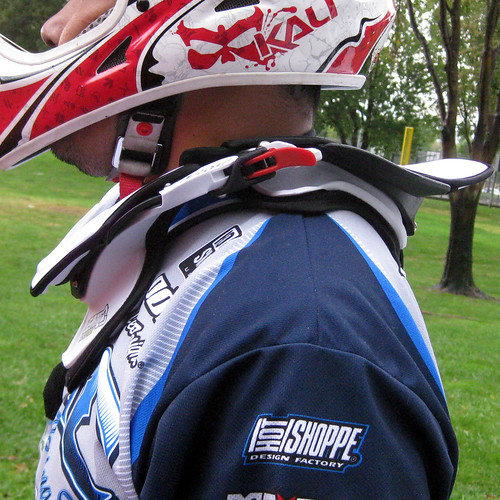
Side view of the DBX Comp
The most important part of wearing the DBX Comp is the fitment. It’s imperative that you are properly fitted to ensure you have the maximum protection. The DBX Comp comes with four pairs of pins to accommodate various sizes:
– Short Pin (0mm)
– Medium Pin (10mm)
– Long Pin (20mm)
– Long Pin (30mm)
Having the Leatt-Brace too big (loose) or too small(tight) can affect the way the brace protects you. The DBX Comp can also be opened or closed on either left or right side. There is a hinge closure that locks onto the pins.
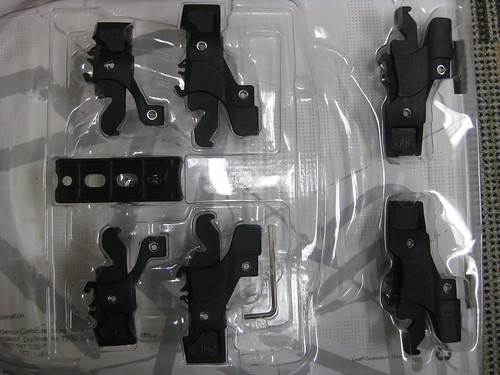
The extra pins; the medium is mounted in the DBX
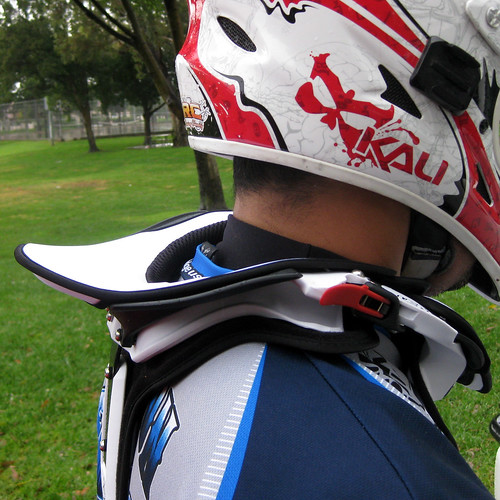
View from the back with the thoracic support
In the racing circuit, I’ve also noticed that the Leatt-Brace has inspired confidence to many riders of all levels. From Professionals to Beginners, they are no longer wearing body armor. Note that body armor is a personal preference, however if you do decide to wear it in conjunction with the DBX, you have to be sure that the thoracic piece is sitting flat on your back and is under the spine protector. Armors that have been in production with thicker chest padding and spine protection will not work well with the DBX… again, proper fitting is key. They now have body armor out in the market that is designed specifically to “fit” with the Leatt-Brace.

Wearing the DBX Comp in the Southridge Finals without body armor.
Real life experience: Since wearing the DBX Comp, I’ve personally experienced how the Leatt-Brace can save your @$$! Jan. 9th 2011 Fontana Winter Series #1, practice run – I was following RL Policar down the DH course. At some point I bobbled at a technical section which caused me to stop and redo. At this point RL was long gone. I continued down the course with out anyone to follow. I came up to a section which was a roller/drop off. I should have stayed on the right side where it was a fairly easy roll. Not knowing which way to go, I went left and the rocks started to gap. End result – Over The Bars (OTB). Point of impact was the right side of my head and I rolled over, slamming my right hip onto the ground. I’d hate to find out what would have happened had I not been wearing the DBX. I walked away with bruises on my right hip, leg and buttocks.
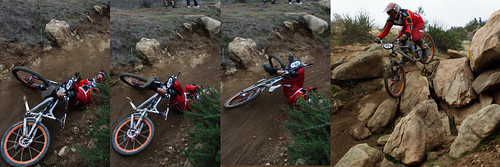
My crash in January. Photo by Tibor Fazekas, www.tibiphoto.com
Not too long before my OTB, I learned that one of my friends, Perfecto (Perf), crashed while on a casual downhill ride. He was at a local secret DH spot in So Cal with a lot of jumps. Now this guy can hit the jumps… but sometimes we all have mishaps. So what happened – Perf crashed hitting his face first, shattering his helmet. A typical face-plant type accident without a Leatt-Brace, the force of the impact is typically transferred from the ground to the helmet; through the helmet to the scull and scull base where it is then transferred through the neck to the back (thoracic spine). With the Leatt-Brace, the force will instead transfer from the ground to the helmet, through the helmet onto the Leatt-Brace once impact is made. Some of the force will then be transferred to the brace and dispersed to the less vulnerable parts of the torso. If the impact is significant enough, the brace is designed to fail in crumple zones (similar to those seen in cars), thereby helping to absorb some of the energy of the impact.
See before and after pictures below. Had he not been wearing the Leatt-Brace, he would have had a serious injury.
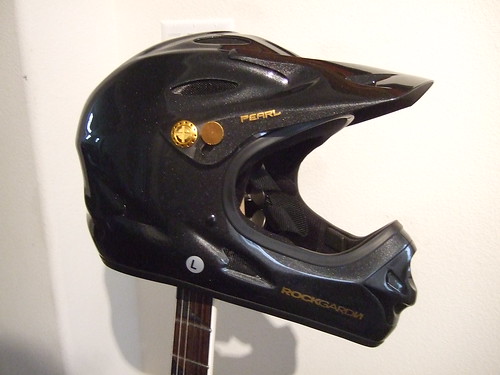
Perf’s helmet when new
So does it work – YES it does! Both scenarios mentioned above could have easily resulted in a more serious injury. Able to walk away from it is priceless. We should always think safety first. Leatt-Brace DBX has other models available – The Ride, the Comp I or II and the Pro. The DBX Comp retails for $395.00. For more information, visit Leatt-Brace at www.leatt-brace.com.

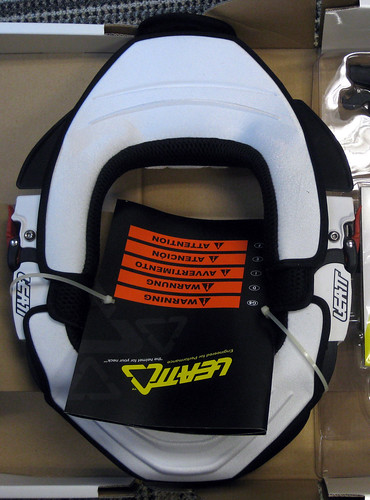

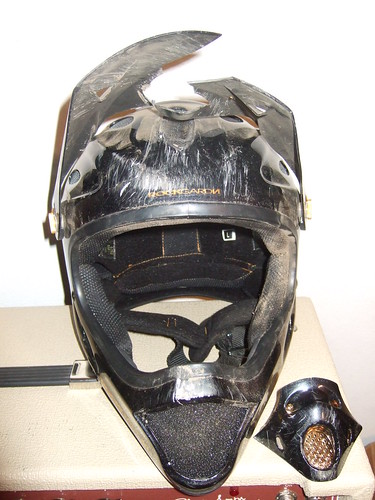
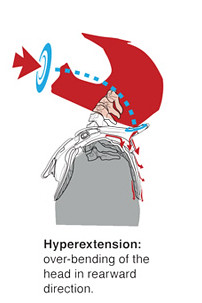
Nice report/review of this product! Thanks for the information.